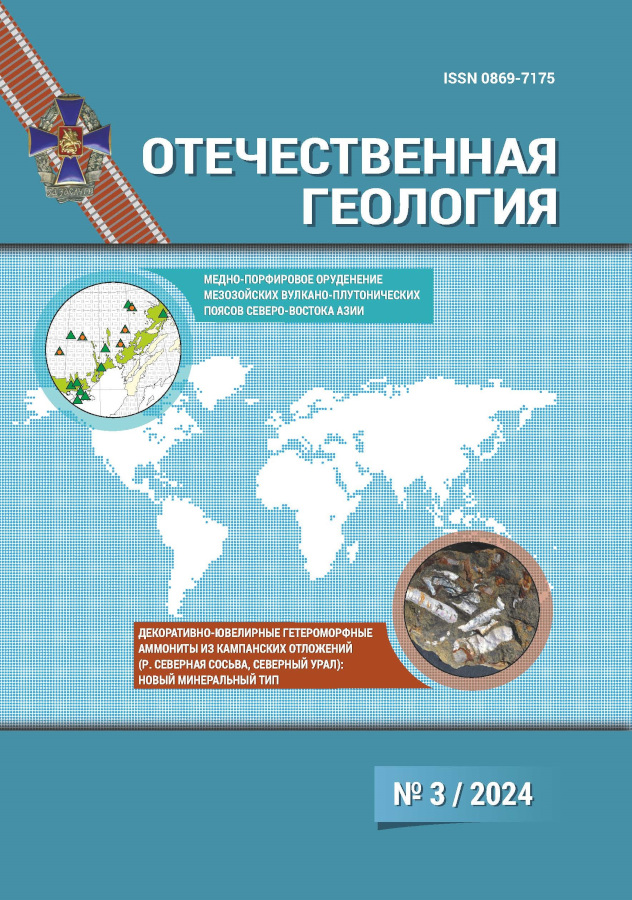Read in the latest issue of the magazine
((click on the title of the article to view the annotation)PETROLOGY, MINERALOGY, GEOCHEMISTRY, LITHOLOGY
North-East Interdisciplinary Scientific Research Institute n. a. N. A. Shilo, FEB RAS, Magadan
Porphyry copper mineralization of various Mesozoic volcano-plutonic belts of Northeastern Asia exhibits both the similarities and differences. There are no significant differences in the composition of granitoids of porphyry copper systems of the different belts. Isotope-geochemical characteristics of the mineralization are contrasting. Objects of the Okhotsk-Chukotka and Oloi belts are characterized by a near-zero isotopic composition of the sulfide sulfur, which corresponds to a magmatic source. Isotopically heavier sulfur of mineralization of the Uyanda-Yasachnaya belt indicates borrowing the ore material from the hosting sedimentary-metamorphic sequences. Data on the ore lead isotopic composition indicate lower crustal sources of the Oloi belt and upper crustal ones of the Uyanda-Yasachnaya belt. The Okhotsk-Chukchi belt is characterized by heterogeneity of the sources of the mineral matter.
Key words: volcanic-plutonic belt, porphyry copper, petrochemical, isotope-geochemical, sources of mineral matter.
Federal State Budgetary Institution "Central Research Institute of Geological Prospecting for Base and Precious Metals" (FSBI "TSNIGRI"), Moscow
Based on studying monazite and xenotime from various ore deposits, a method for identifying these minerals under an IR microscope has been developed. The spectral characteristics of monazite and xenotime have been revealed, determined by their content of isomorphic and phase impurities. The data obtained can be used for technological mapping of deposits of rare earth elements, as well as for the forecasting and prospecting purposes.
Key words:monazite, xenotime, phosphates, rare earth elements, typomorphism, FTIR microscope, IR spectra, wave number.
1Sergo Ordzhonikidze Russian State Geological Prospecting University (MGRI), Moscow
2Lomonosov Moscow State University (MSU), Moscow
The article presents results of a study of ammonites with the heteromorphic shell from Campanian deposits of the Upper Cretaceous, Severnaya Sosva River, as an industrial mineral providing the decorative specimens and jewelry material. The complex of investigation of the ammonite shells included determinations of their density, microhardness, luminescence, mineral and chemical composition and the optical petrographic and electron microscopic studies. The ammonite shells consist predominantly of quartz (more than 79 wt. %) represented mostly (more than 52 wt. %) by an amorphous form. The cherty siltstone filling the destroyed ammonite chambers also contains cristobalite, tridymite, albite, microcline, glauconite, illite and smectite, pyrite, ilmenite, and iron hydroxides. Of the impurity elements, increased contents of Ba (about 0.0129 wt. %) and Cr, V, Zn, Rb, Sr, and Zr (less than 0.01 wt. %) were determined. Based on the mineral composition, the ammonite shells are classified as a new siliceous type. The walls of the shells are characterized by bright colored iridescence, which is associated with preservation of the structure of the original aragonite lamellas completely replaced by quartz in the crystalline and amorphous forms. The bright colored iridescence of the shells makes it possible to use the ammonites as a gem stone material. A new mineral type of ammolite, the siliceous ammolite, has been established. The ammonite shells may be gathered from the Campanian deposits in coastal cliffs or talus without mining workings, which does not require significant material costs and does not disturb the environment.
Key words: ammonite, ammolite, jewelry materials, Campanian, Upper Cretaceous, Northern Urals.
REGIONAL GEOLOGY
West-Yakutian Scientific Center (WYSC) of the Academy of Sciences of the Republic of Sakha (Yakutia), Mirny
A brief description is presented of the geological and tectonic structure and peculiarities of the development of the Siberian Platform (SP), beginning from the Archean and ending by the formation of Quaternary deposits. Particular attention is given to the Upper Paleozoic and Mesozoic terrigenous sequences of the main diamond-bearing regions of the SP, that are promising for prospection of diamond deposits. It is shown that five large lithological-facial complexes separated by regional unconformities are clearly distinguished in the platform cover section: the Vendian-Lower Silurian, Middle Paleozoic (Devonian-Lower Carboniferous), Upper Paleozoic-Lower Mesozoic, Mesozoic-Tertiary, and Quaternary ones. Igneous formations are represented by the basic (traps) and alkaline-ultrabasic (kimberlites, carbonatites) groups of rocks.
Key words: Siberian platform, diamond-bearing regions, structural-formational zones.
DISCUSSIONS
OOO “Geopoisk”, Ekaterinburg
The necessary distinguishing of the Kuzhinskaya series leads to the conclusion, that its deposits, along with other Neoproterozoic series, are incorporated into the Timanides collision belt framing the Proto-Ural continent composed of the Lower and Middle Riphean. Zones of the Early Riphean and Neoproterozoic collision caused an effect upon the distribution of mineral deposits.
Key words: Timanides collision belt, Neoproterozoic, Proto-Ural continent, Lower and Middle Riphean, mineral resources.
